Enterprise Leadership: Managerial Decision-Making at Telstra - Report
VerifiedAdded on 2020/03/01
|10
|1671
|432
Report
AI Summary
This report critically analyzes the role of managers as decision-makers within an organization, using Telstra as a case study. It examines the importance of effective decision-making in today's business environment, highlighting the steps involved in the decision-making process, and how managers at Telstra have addressed challenges such as employee retention and organizational culture. The report delves into Telstra's response to employee turnover, the revision of HR policies, and the implementation of strategies to improve employee experience, including the introduction of the My Future platform and leadership training programs. The methodology employed includes a review of business articles, published journals, and case studies, as well as an evaluation of management theories. The conclusion emphasizes the significance of informed decision-making for organizational success, especially in competitive markets. This report is a valuable resource for understanding how managerial decisions can impact an organization's performance and employee satisfaction.
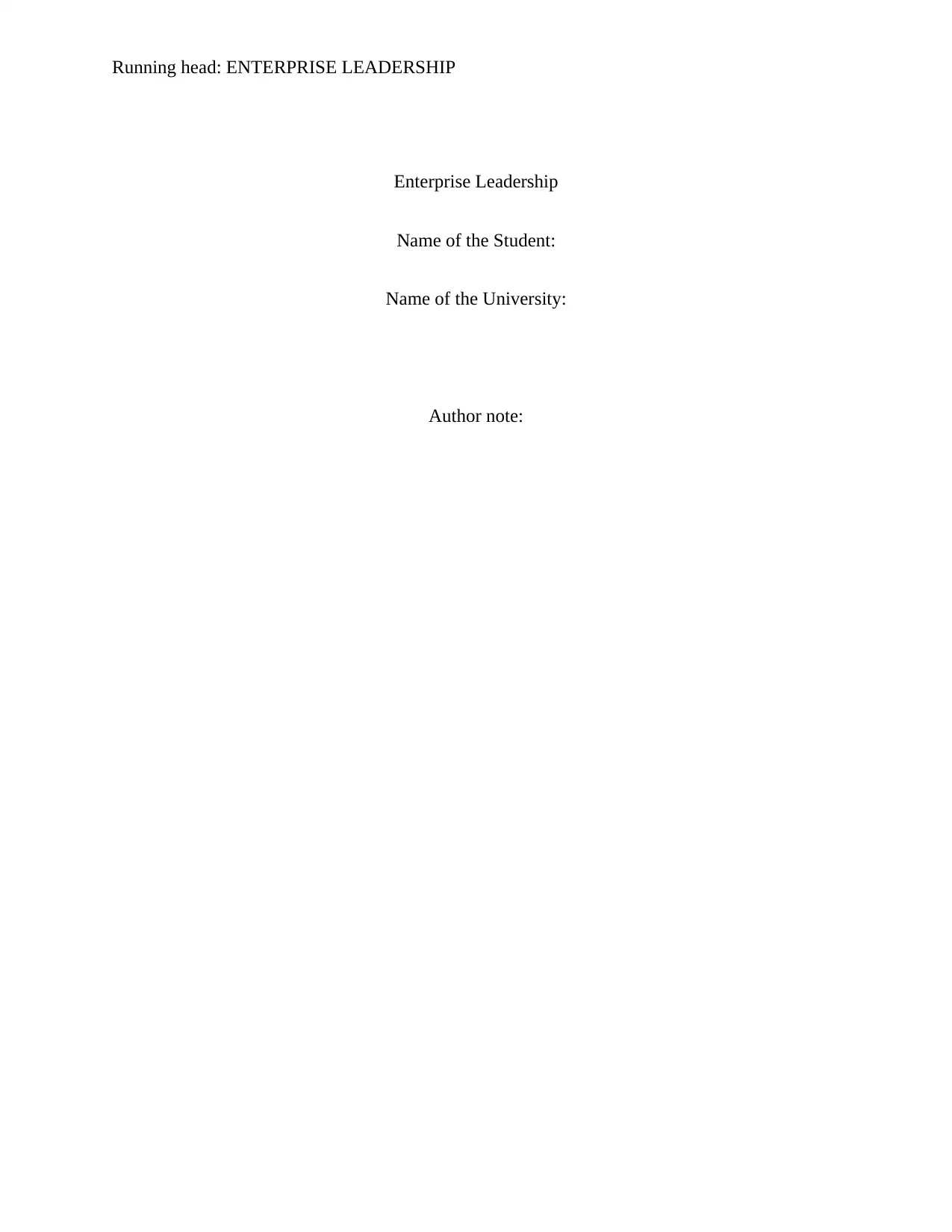
Running head: ENTERPRISE LEADERSHIP
Enterprise Leadership
Name of the Student:
Name of the University:
Author note:
Enterprise Leadership
Name of the Student:
Name of the University:
Author note:
Paraphrase This Document
Need a fresh take? Get an instant paraphrase of this document with our AI Paraphraser
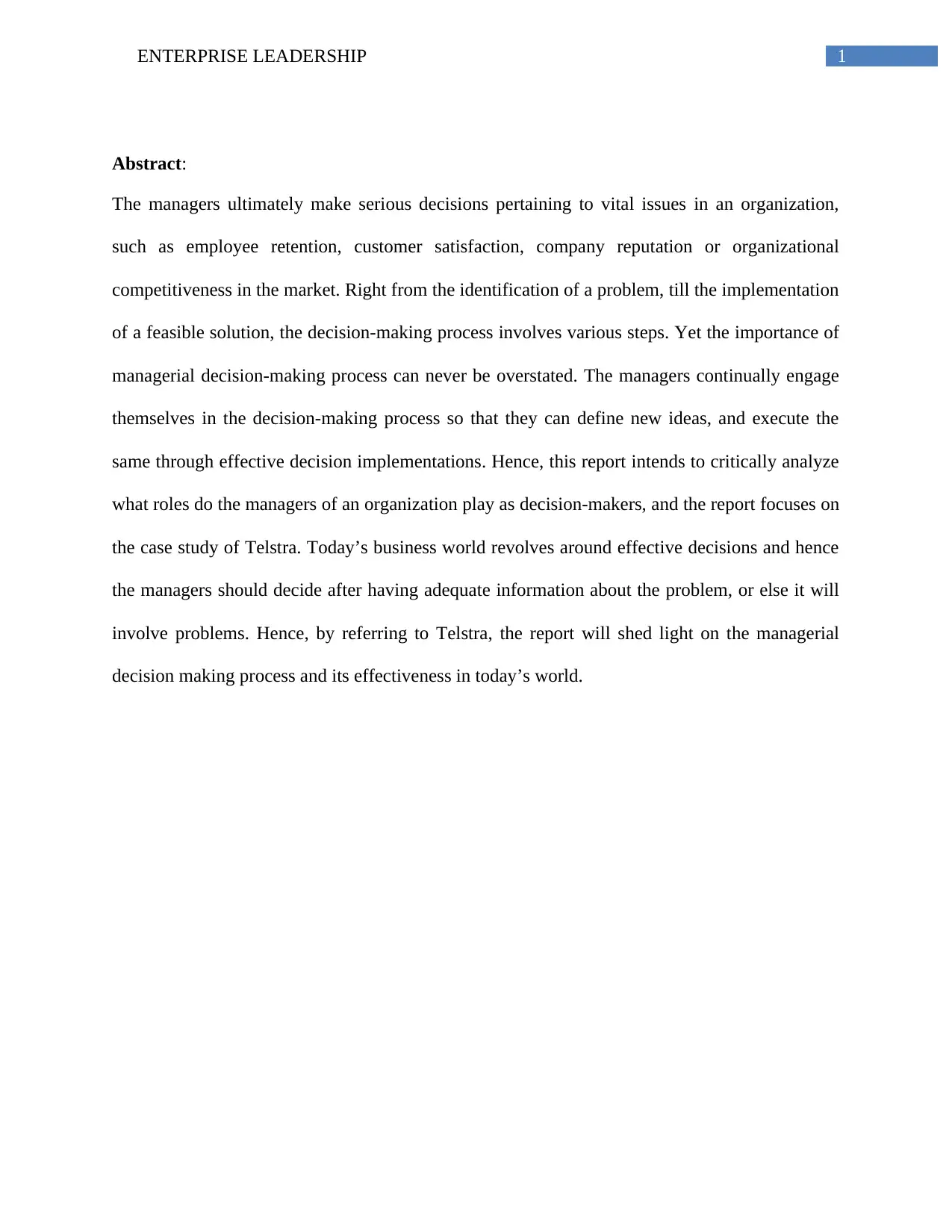
1ENTERPRISE LEADERSHIP
Abstract:
The managers ultimately make serious decisions pertaining to vital issues in an organization,
such as employee retention, customer satisfaction, company reputation or organizational
competitiveness in the market. Right from the identification of a problem, till the implementation
of a feasible solution, the decision-making process involves various steps. Yet the importance of
managerial decision-making process can never be overstated. The managers continually engage
themselves in the decision-making process so that they can define new ideas, and execute the
same through effective decision implementations. Hence, this report intends to critically analyze
what roles do the managers of an organization play as decision-makers, and the report focuses on
the case study of Telstra. Today’s business world revolves around effective decisions and hence
the managers should decide after having adequate information about the problem, or else it will
involve problems. Hence, by referring to Telstra, the report will shed light on the managerial
decision making process and its effectiveness in today’s world.
Abstract:
The managers ultimately make serious decisions pertaining to vital issues in an organization,
such as employee retention, customer satisfaction, company reputation or organizational
competitiveness in the market. Right from the identification of a problem, till the implementation
of a feasible solution, the decision-making process involves various steps. Yet the importance of
managerial decision-making process can never be overstated. The managers continually engage
themselves in the decision-making process so that they can define new ideas, and execute the
same through effective decision implementations. Hence, this report intends to critically analyze
what roles do the managers of an organization play as decision-makers, and the report focuses on
the case study of Telstra. Today’s business world revolves around effective decisions and hence
the managers should decide after having adequate information about the problem, or else it will
involve problems. Hence, by referring to Telstra, the report will shed light on the managerial
decision making process and its effectiveness in today’s world.
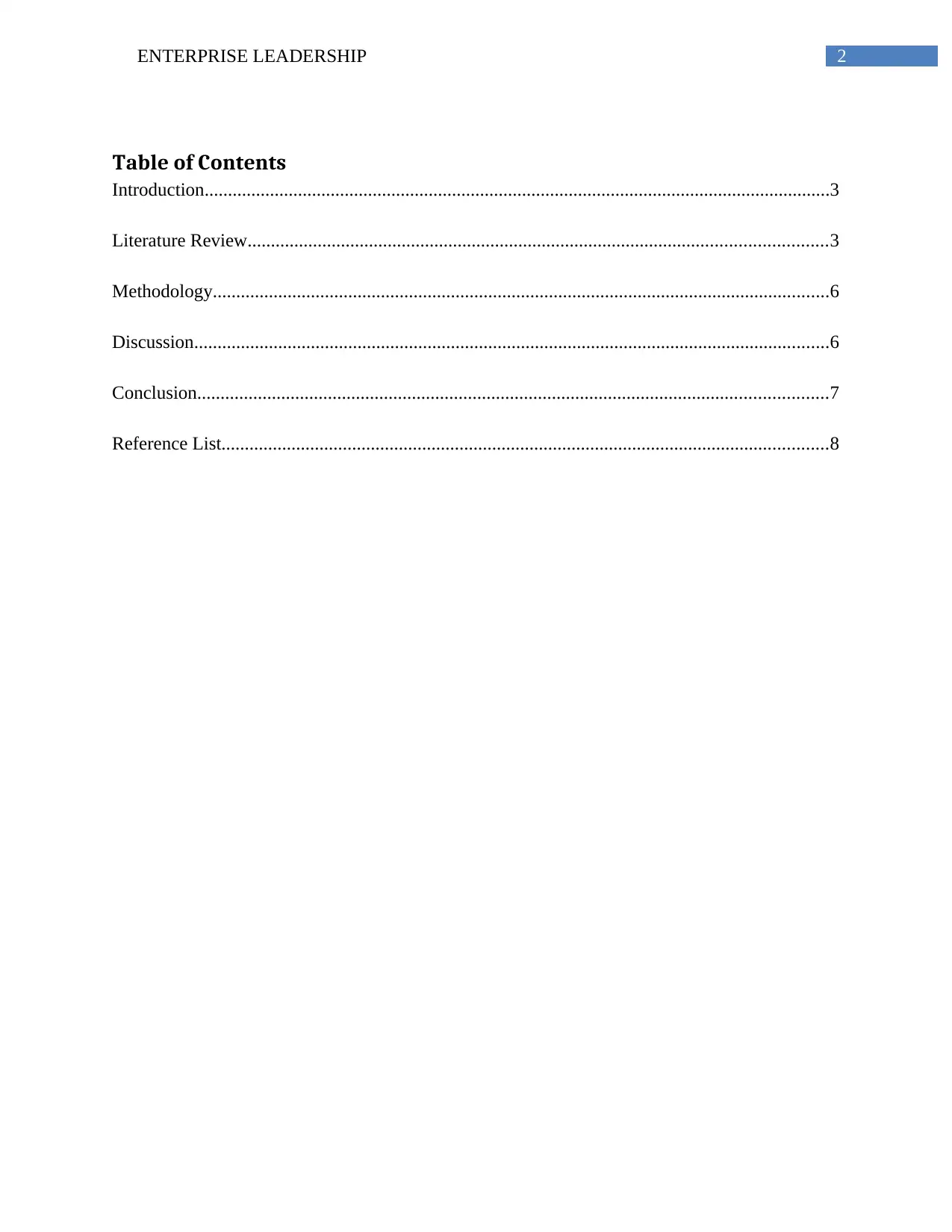
2ENTERPRISE LEADERSHIP
Table of Contents
Introduction......................................................................................................................................3
Literature Review............................................................................................................................3
Methodology....................................................................................................................................6
Discussion........................................................................................................................................6
Conclusion.......................................................................................................................................7
Reference List..................................................................................................................................8
Table of Contents
Introduction......................................................................................................................................3
Literature Review............................................................................................................................3
Methodology....................................................................................................................................6
Discussion........................................................................................................................................6
Conclusion.......................................................................................................................................7
Reference List..................................................................................................................................8
⊘ This is a preview!⊘
Do you want full access?
Subscribe today to unlock all pages.

Trusted by 1+ million students worldwide
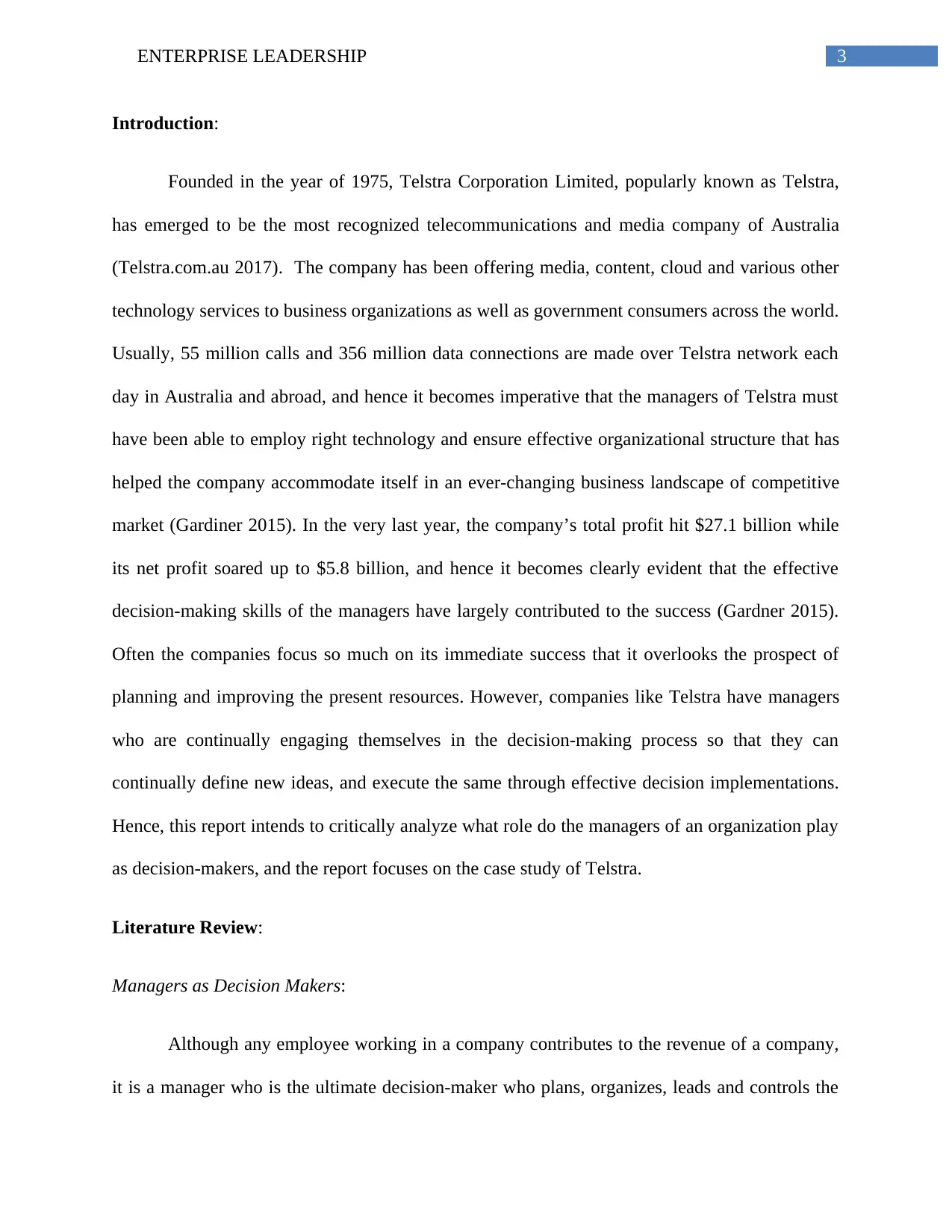
3ENTERPRISE LEADERSHIP
Introduction:
Founded in the year of 1975, Telstra Corporation Limited, popularly known as Telstra,
has emerged to be the most recognized telecommunications and media company of Australia
(Telstra.com.au 2017). The company has been offering media, content, cloud and various other
technology services to business organizations as well as government consumers across the world.
Usually, 55 million calls and 356 million data connections are made over Telstra network each
day in Australia and abroad, and hence it becomes imperative that the managers of Telstra must
have been able to employ right technology and ensure effective organizational structure that has
helped the company accommodate itself in an ever-changing business landscape of competitive
market (Gardiner 2015). In the very last year, the company’s total profit hit $27.1 billion while
its net profit soared up to $5.8 billion, and hence it becomes clearly evident that the effective
decision-making skills of the managers have largely contributed to the success (Gardner 2015).
Often the companies focus so much on its immediate success that it overlooks the prospect of
planning and improving the present resources. However, companies like Telstra have managers
who are continually engaging themselves in the decision-making process so that they can
continually define new ideas, and execute the same through effective decision implementations.
Hence, this report intends to critically analyze what role do the managers of an organization play
as decision-makers, and the report focuses on the case study of Telstra.
Literature Review:
Managers as Decision Makers:
Although any employee working in a company contributes to the revenue of a company,
it is a manager who is the ultimate decision-maker who plans, organizes, leads and controls the
Introduction:
Founded in the year of 1975, Telstra Corporation Limited, popularly known as Telstra,
has emerged to be the most recognized telecommunications and media company of Australia
(Telstra.com.au 2017). The company has been offering media, content, cloud and various other
technology services to business organizations as well as government consumers across the world.
Usually, 55 million calls and 356 million data connections are made over Telstra network each
day in Australia and abroad, and hence it becomes imperative that the managers of Telstra must
have been able to employ right technology and ensure effective organizational structure that has
helped the company accommodate itself in an ever-changing business landscape of competitive
market (Gardiner 2015). In the very last year, the company’s total profit hit $27.1 billion while
its net profit soared up to $5.8 billion, and hence it becomes clearly evident that the effective
decision-making skills of the managers have largely contributed to the success (Gardner 2015).
Often the companies focus so much on its immediate success that it overlooks the prospect of
planning and improving the present resources. However, companies like Telstra have managers
who are continually engaging themselves in the decision-making process so that they can
continually define new ideas, and execute the same through effective decision implementations.
Hence, this report intends to critically analyze what role do the managers of an organization play
as decision-makers, and the report focuses on the case study of Telstra.
Literature Review:
Managers as Decision Makers:
Although any employee working in a company contributes to the revenue of a company,
it is a manager who is the ultimate decision-maker who plans, organizes, leads and controls the
Paraphrase This Document
Need a fresh take? Get an instant paraphrase of this document with our AI Paraphraser
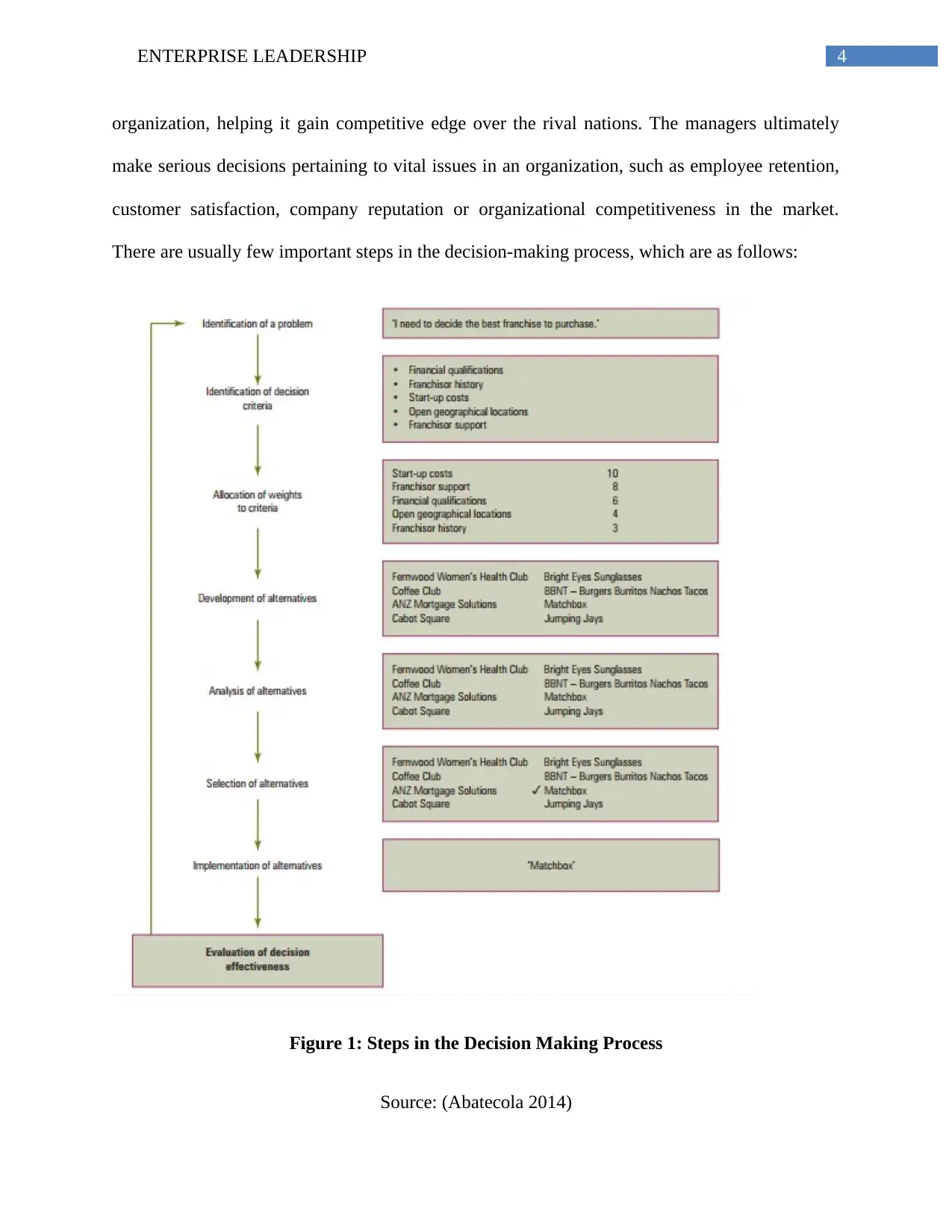
4ENTERPRISE LEADERSHIP
organization, helping it gain competitive edge over the rival nations. The managers ultimately
make serious decisions pertaining to vital issues in an organization, such as employee retention,
customer satisfaction, company reputation or organizational competitiveness in the market.
There are usually few important steps in the decision-making process, which are as follows:
Figure 1: Steps in the Decision Making Process
Source: (Abatecola 2014)
organization, helping it gain competitive edge over the rival nations. The managers ultimately
make serious decisions pertaining to vital issues in an organization, such as employee retention,
customer satisfaction, company reputation or organizational competitiveness in the market.
There are usually few important steps in the decision-making process, which are as follows:
Figure 1: Steps in the Decision Making Process
Source: (Abatecola 2014)
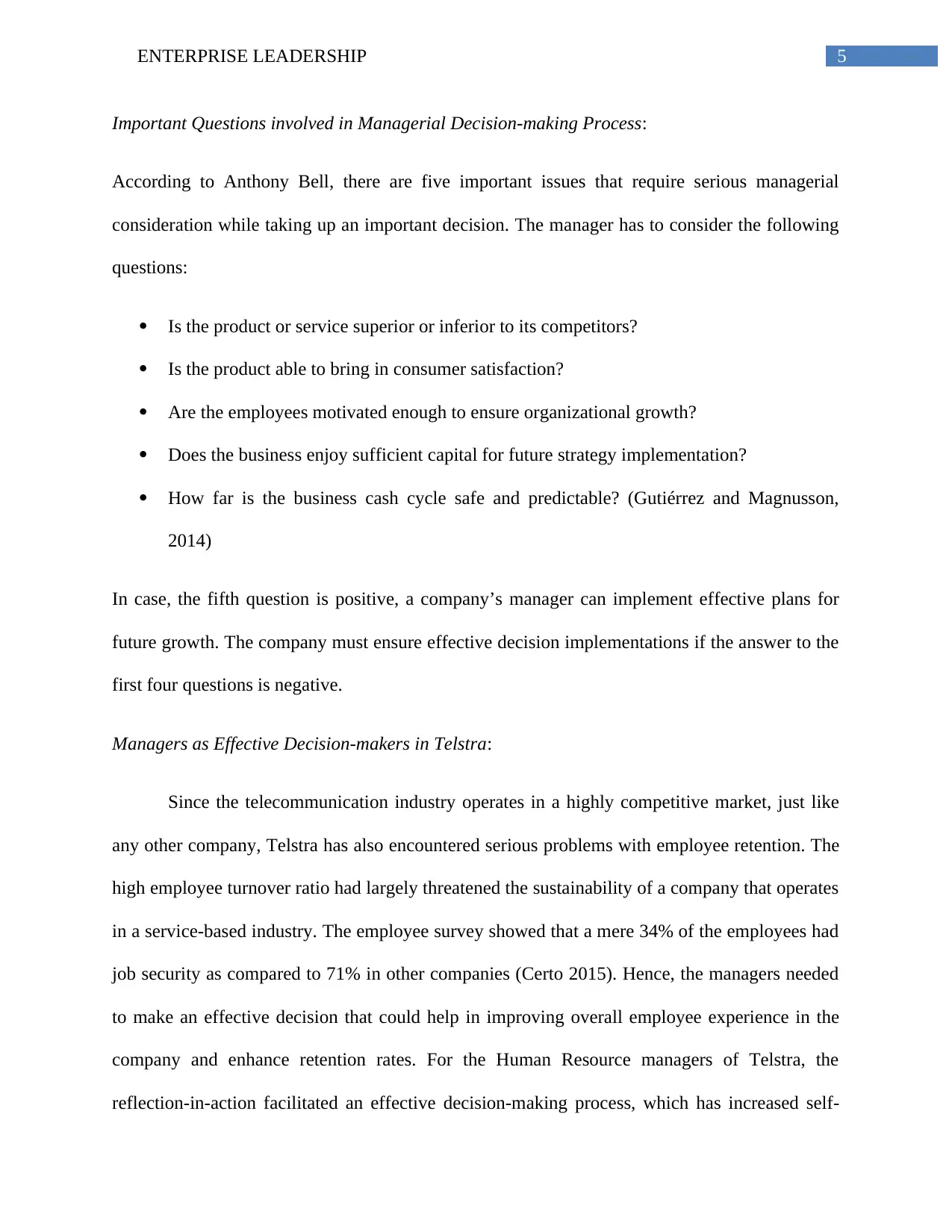
5ENTERPRISE LEADERSHIP
Important Questions involved in Managerial Decision-making Process:
According to Anthony Bell, there are five important issues that require serious managerial
consideration while taking up an important decision. The manager has to consider the following
questions:
Is the product or service superior or inferior to its competitors?
Is the product able to bring in consumer satisfaction?
Are the employees motivated enough to ensure organizational growth?
Does the business enjoy sufficient capital for future strategy implementation?
How far is the business cash cycle safe and predictable? (Gutiérrez and Magnusson,
2014)
In case, the fifth question is positive, a company’s manager can implement effective plans for
future growth. The company must ensure effective decision implementations if the answer to the
first four questions is negative.
Managers as Effective Decision-makers in Telstra:
Since the telecommunication industry operates in a highly competitive market, just like
any other company, Telstra has also encountered serious problems with employee retention. The
high employee turnover ratio had largely threatened the sustainability of a company that operates
in a service-based industry. The employee survey showed that a mere 34% of the employees had
job security as compared to 71% in other companies (Certo 2015). Hence, the managers needed
to make an effective decision that could help in improving overall employee experience in the
company and enhance retention rates. For the Human Resource managers of Telstra, the
reflection-in-action facilitated an effective decision-making process, which has increased self-
Important Questions involved in Managerial Decision-making Process:
According to Anthony Bell, there are five important issues that require serious managerial
consideration while taking up an important decision. The manager has to consider the following
questions:
Is the product or service superior or inferior to its competitors?
Is the product able to bring in consumer satisfaction?
Are the employees motivated enough to ensure organizational growth?
Does the business enjoy sufficient capital for future strategy implementation?
How far is the business cash cycle safe and predictable? (Gutiérrez and Magnusson,
2014)
In case, the fifth question is positive, a company’s manager can implement effective plans for
future growth. The company must ensure effective decision implementations if the answer to the
first four questions is negative.
Managers as Effective Decision-makers in Telstra:
Since the telecommunication industry operates in a highly competitive market, just like
any other company, Telstra has also encountered serious problems with employee retention. The
high employee turnover ratio had largely threatened the sustainability of a company that operates
in a service-based industry. The employee survey showed that a mere 34% of the employees had
job security as compared to 71% in other companies (Certo 2015). Hence, the managers needed
to make an effective decision that could help in improving overall employee experience in the
company and enhance retention rates. For the Human Resource managers of Telstra, the
reflection-in-action facilitated an effective decision-making process, which has increased self-
⊘ This is a preview!⊘
Do you want full access?
Subscribe today to unlock all pages.

Trusted by 1+ million students worldwide
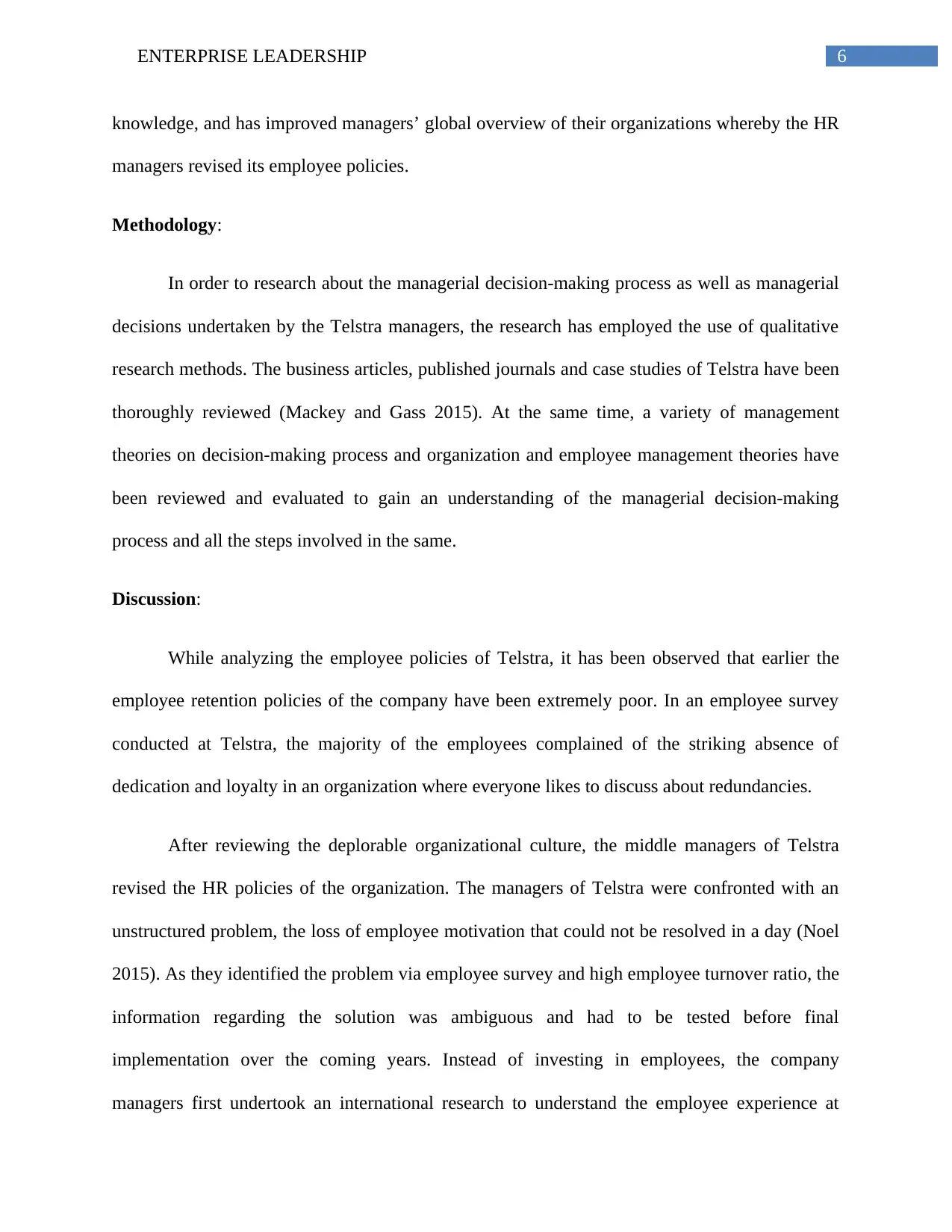
6ENTERPRISE LEADERSHIP
knowledge, and has improved managers’ global overview of their organizations whereby the HR
managers revised its employee policies.
Methodology:
In order to research about the managerial decision-making process as well as managerial
decisions undertaken by the Telstra managers, the research has employed the use of qualitative
research methods. The business articles, published journals and case studies of Telstra have been
thoroughly reviewed (Mackey and Gass 2015). At the same time, a variety of management
theories on decision-making process and organization and employee management theories have
been reviewed and evaluated to gain an understanding of the managerial decision-making
process and all the steps involved in the same.
Discussion:
While analyzing the employee policies of Telstra, it has been observed that earlier the
employee retention policies of the company have been extremely poor. In an employee survey
conducted at Telstra, the majority of the employees complained of the striking absence of
dedication and loyalty in an organization where everyone likes to discuss about redundancies.
After reviewing the deplorable organizational culture, the middle managers of Telstra
revised the HR policies of the organization. The managers of Telstra were confronted with an
unstructured problem, the loss of employee motivation that could not be resolved in a day (Noel
2015). As they identified the problem via employee survey and high employee turnover ratio, the
information regarding the solution was ambiguous and had to be tested before final
implementation over the coming years. Instead of investing in employees, the company
managers first undertook an international research to understand the employee experience at
knowledge, and has improved managers’ global overview of their organizations whereby the HR
managers revised its employee policies.
Methodology:
In order to research about the managerial decision-making process as well as managerial
decisions undertaken by the Telstra managers, the research has employed the use of qualitative
research methods. The business articles, published journals and case studies of Telstra have been
thoroughly reviewed (Mackey and Gass 2015). At the same time, a variety of management
theories on decision-making process and organization and employee management theories have
been reviewed and evaluated to gain an understanding of the managerial decision-making
process and all the steps involved in the same.
Discussion:
While analyzing the employee policies of Telstra, it has been observed that earlier the
employee retention policies of the company have been extremely poor. In an employee survey
conducted at Telstra, the majority of the employees complained of the striking absence of
dedication and loyalty in an organization where everyone likes to discuss about redundancies.
After reviewing the deplorable organizational culture, the middle managers of Telstra
revised the HR policies of the organization. The managers of Telstra were confronted with an
unstructured problem, the loss of employee motivation that could not be resolved in a day (Noel
2015). As they identified the problem via employee survey and high employee turnover ratio, the
information regarding the solution was ambiguous and had to be tested before final
implementation over the coming years. Instead of investing in employees, the company
managers first undertook an international research to understand the employee experience at
Paraphrase This Document
Need a fresh take? Get an instant paraphrase of this document with our AI Paraphraser
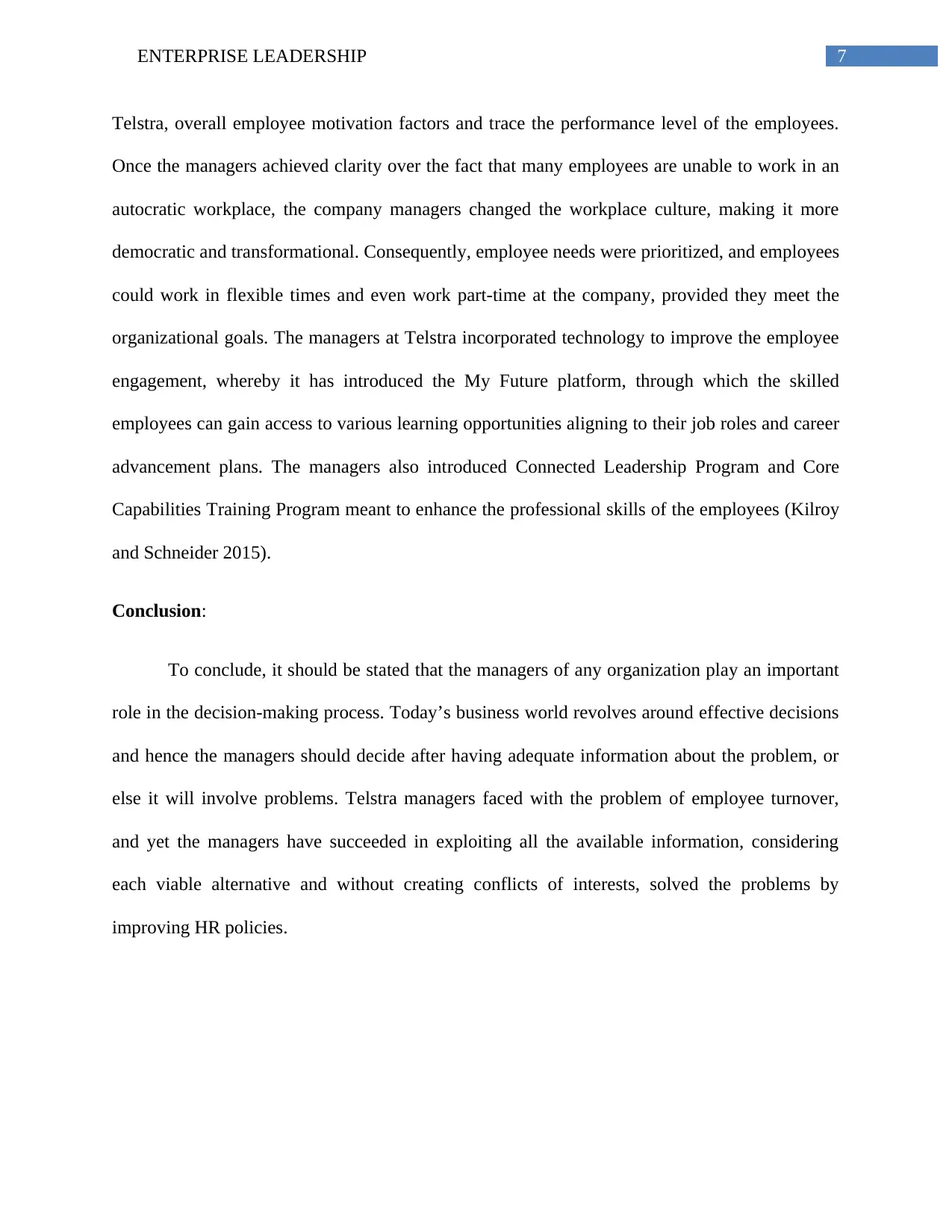
7ENTERPRISE LEADERSHIP
Telstra, overall employee motivation factors and trace the performance level of the employees.
Once the managers achieved clarity over the fact that many employees are unable to work in an
autocratic workplace, the company managers changed the workplace culture, making it more
democratic and transformational. Consequently, employee needs were prioritized, and employees
could work in flexible times and even work part-time at the company, provided they meet the
organizational goals. The managers at Telstra incorporated technology to improve the employee
engagement, whereby it has introduced the My Future platform, through which the skilled
employees can gain access to various learning opportunities aligning to their job roles and career
advancement plans. The managers also introduced Connected Leadership Program and Core
Capabilities Training Program meant to enhance the professional skills of the employees (Kilroy
and Schneider 2015).
Conclusion:
To conclude, it should be stated that the managers of any organization play an important
role in the decision-making process. Today’s business world revolves around effective decisions
and hence the managers should decide after having adequate information about the problem, or
else it will involve problems. Telstra managers faced with the problem of employee turnover,
and yet the managers have succeeded in exploiting all the available information, considering
each viable alternative and without creating conflicts of interests, solved the problems by
improving HR policies.
Telstra, overall employee motivation factors and trace the performance level of the employees.
Once the managers achieved clarity over the fact that many employees are unable to work in an
autocratic workplace, the company managers changed the workplace culture, making it more
democratic and transformational. Consequently, employee needs were prioritized, and employees
could work in flexible times and even work part-time at the company, provided they meet the
organizational goals. The managers at Telstra incorporated technology to improve the employee
engagement, whereby it has introduced the My Future platform, through which the skilled
employees can gain access to various learning opportunities aligning to their job roles and career
advancement plans. The managers also introduced Connected Leadership Program and Core
Capabilities Training Program meant to enhance the professional skills of the employees (Kilroy
and Schneider 2015).
Conclusion:
To conclude, it should be stated that the managers of any organization play an important
role in the decision-making process. Today’s business world revolves around effective decisions
and hence the managers should decide after having adequate information about the problem, or
else it will involve problems. Telstra managers faced with the problem of employee turnover,
and yet the managers have succeeded in exploiting all the available information, considering
each viable alternative and without creating conflicts of interests, solved the problems by
improving HR policies.
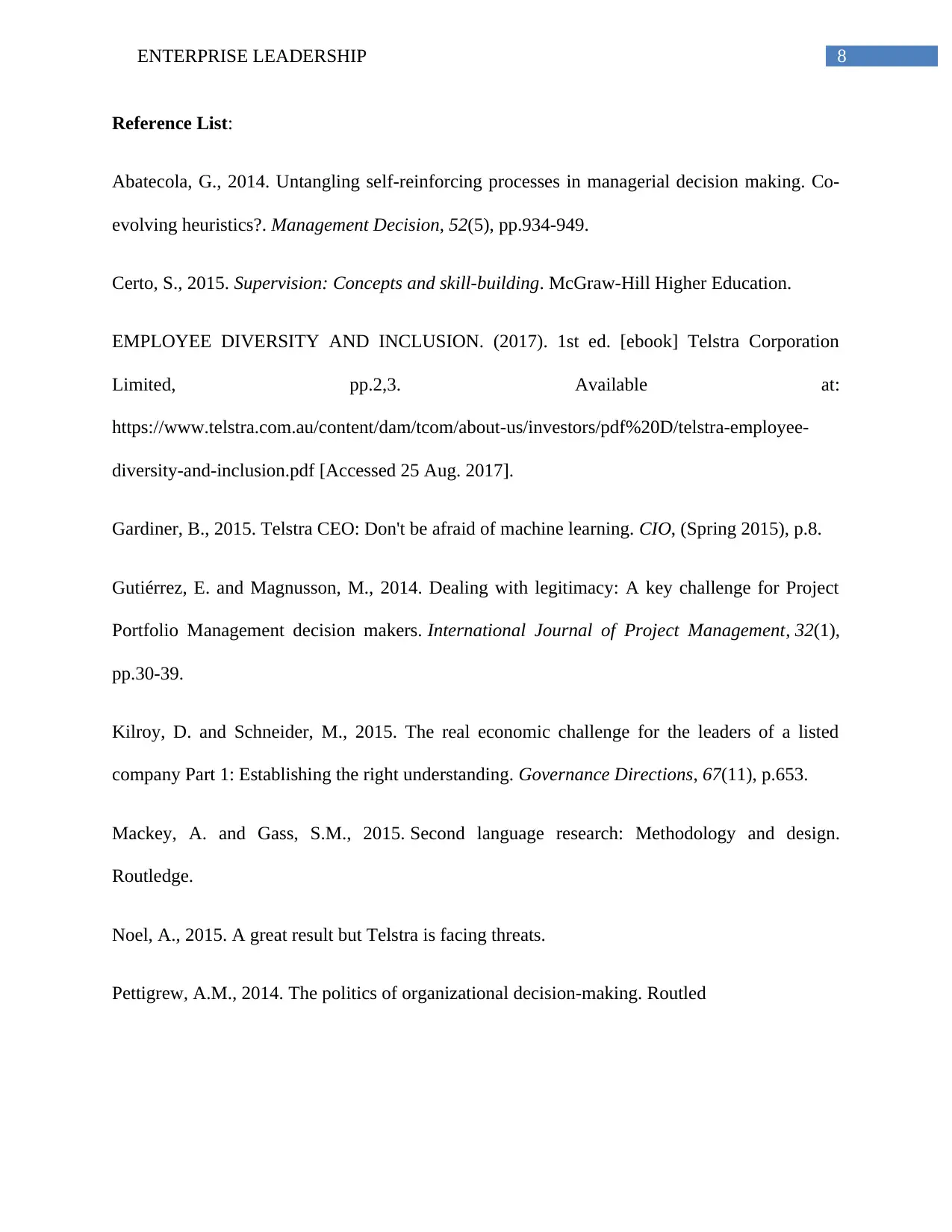
8ENTERPRISE LEADERSHIP
Reference List:
Abatecola, G., 2014. Untangling self-reinforcing processes in managerial decision making. Co-
evolving heuristics?. Management Decision, 52(5), pp.934-949.
Certo, S., 2015. Supervision: Concepts and skill-building. McGraw-Hill Higher Education.
EMPLOYEE DIVERSITY AND INCLUSION. (2017). 1st ed. [ebook] Telstra Corporation
Limited, pp.2,3. Available at:
https://www.telstra.com.au/content/dam/tcom/about-us/investors/pdf%20D/telstra-employee-
diversity-and-inclusion.pdf [Accessed 25 Aug. 2017].
Gardiner, B., 2015. Telstra CEO: Don't be afraid of machine learning. CIO, (Spring 2015), p.8.
Gutiérrez, E. and Magnusson, M., 2014. Dealing with legitimacy: A key challenge for Project
Portfolio Management decision makers. International Journal of Project Management, 32(1),
pp.30-39.
Kilroy, D. and Schneider, M., 2015. The real economic challenge for the leaders of a listed
company Part 1: Establishing the right understanding. Governance Directions, 67(11), p.653.
Mackey, A. and Gass, S.M., 2015. Second language research: Methodology and design.
Routledge.
Noel, A., 2015. A great result but Telstra is facing threats.
Pettigrew, A.M., 2014. The politics of organizational decision-making. Routled
Reference List:
Abatecola, G., 2014. Untangling self-reinforcing processes in managerial decision making. Co-
evolving heuristics?. Management Decision, 52(5), pp.934-949.
Certo, S., 2015. Supervision: Concepts and skill-building. McGraw-Hill Higher Education.
EMPLOYEE DIVERSITY AND INCLUSION. (2017). 1st ed. [ebook] Telstra Corporation
Limited, pp.2,3. Available at:
https://www.telstra.com.au/content/dam/tcom/about-us/investors/pdf%20D/telstra-employee-
diversity-and-inclusion.pdf [Accessed 25 Aug. 2017].
Gardiner, B., 2015. Telstra CEO: Don't be afraid of machine learning. CIO, (Spring 2015), p.8.
Gutiérrez, E. and Magnusson, M., 2014. Dealing with legitimacy: A key challenge for Project
Portfolio Management decision makers. International Journal of Project Management, 32(1),
pp.30-39.
Kilroy, D. and Schneider, M., 2015. The real economic challenge for the leaders of a listed
company Part 1: Establishing the right understanding. Governance Directions, 67(11), p.653.
Mackey, A. and Gass, S.M., 2015. Second language research: Methodology and design.
Routledge.
Noel, A., 2015. A great result but Telstra is facing threats.
Pettigrew, A.M., 2014. The politics of organizational decision-making. Routled
⊘ This is a preview!⊘
Do you want full access?
Subscribe today to unlock all pages.

Trusted by 1+ million students worldwide

9ENTERPRISE LEADERSHIP
Telstra.com.au. 2017. Telstra - mobile phones, prepaid phones, broadband, internet, home
phones, business phones. [online] Available at: https://www.telstra.com.au/ [Accessed 25 Aug.
2017].
Telstra.com.au. 2017. Telstra - mobile phones, prepaid phones, broadband, internet, home
phones, business phones. [online] Available at: https://www.telstra.com.au/ [Accessed 25 Aug.
2017].
1 out of 10
Related Documents
Your All-in-One AI-Powered Toolkit for Academic Success.
+13062052269
info@desklib.com
Available 24*7 on WhatsApp / Email
![[object Object]](/_next/static/media/star-bottom.7253800d.svg)
Unlock your academic potential
Copyright © 2020–2025 A2Z Services. All Rights Reserved. Developed and managed by ZUCOL.





